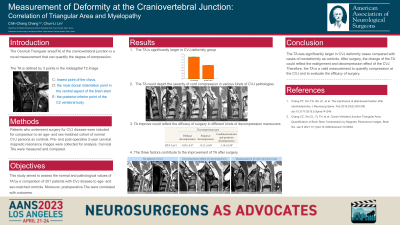Measurement of Deformity at the Craniovertebral Junction: Correlation of Triangular Area and Myelopathy
Friday, April 21, 2023

- CC
Chang Chih-Chang, n/a (he/him/his)
Attending physician
Taipei Veterans General Hospital
Taipei, Taiwan (Republic of China)
Presenting Author(s)
Introduction: Diseases of the craniovertebral junction (CVJ) are commonly associated with deformity, malalignment, and subsequent myelopathy. The misaligned CVJ might cause compression of neuronal tissues and subsequently clinical symptoms. The triangular area (TA), measured by magnetic resonance images (MRIs), is a novel measurement for quantification of the severity of compression to the brain stem. This study aimed to assess the normal and pathological values of TA by comparison of patients with CVJ disease to age- and sex-matched healthy controls. Moreover, post-operative TAs were correlated with outcomes.
Methods: Consecutive patients who underwent surgery for CVJ disease were included for comparison to an age- and sex-matched cohort of normal CVJ as healthy controls. The demographics, peri-operative information, pre- and post-operative 2-year cervical magnetic resonance image were collected for analysis. Cervical TA was measured and compared.
Results: A total of 201 patients who all had pre- or post-operative MRIs were analyzed. The TA of CVJ deformity group was larger than the healthy control group(1.62 ± 0.57 vs 1.01± 0.18 cm2, p< 0.0001). Two years after surgery, TA decreased by 0.2 cm2 in patients with fixation-alone surgery and 0.21 cm2 in patients with decompressive laminectomy plus fixation surgery. Moreover, patients who had combined anterior odontoidectomy and posterior laminectomy with fixation had the greatest reduction in TA(1.18 ± 0.58 cm2).
Conclusion : In CVJ deformity, the measurement of cervical TA could indicate the severity of brain stem compression. After surgery, the TA had a varying degree of improvement which could represent the efficacy of surgery.
Methods: Consecutive patients who underwent surgery for CVJ disease were included for comparison to an age- and sex-matched cohort of normal CVJ as healthy controls. The demographics, peri-operative information, pre- and post-operative 2-year cervical magnetic resonance image were collected for analysis. Cervical TA was measured and compared.
Results: A total of 201 patients who all had pre- or post-operative MRIs were analyzed. The TA of CVJ deformity group was larger than the healthy control group(1.62 ± 0.57 vs 1.01± 0.18 cm2, p< 0.0001). Two years after surgery, TA decreased by 0.2 cm2 in patients with fixation-alone surgery and 0.21 cm2 in patients with decompressive laminectomy plus fixation surgery. Moreover, patients who had combined anterior odontoidectomy and posterior laminectomy with fixation had the greatest reduction in TA(1.18 ± 0.58 cm2).
Conclusion : In CVJ deformity, the measurement of cervical TA could indicate the severity of brain stem compression. After surgery, the TA had a varying degree of improvement which could represent the efficacy of surgery.
